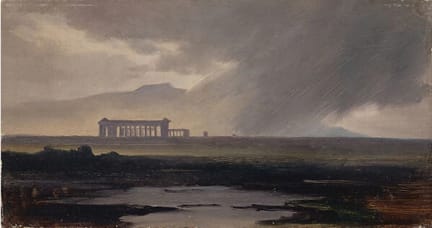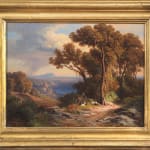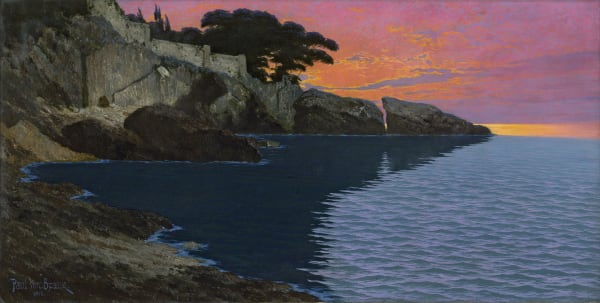

Johann Jakob FREY BASLE 1813 -FRASCATI 1865
Oil on canvas
SOLD
Provenance
Private collection, Germany; private collection, United States
When the Basel painter Johann Jakob Frey arrived in Rome in the third decade of the 19th century, the Eternal City was beginning to lose its centuries-old role as the capital of the arts, and yet it experienced an intense artistic season in which the large German community could boast of a certain eminence and the heritage of such important figures as the Nazarene painters, Joseph Anton Koch and Johann Christian Reinhart.
Frey first stayed in Via di S. Isidoro (now Via degli Artisti), named after the homonymous convent which had welcomed the Nazarenes, the one so gracefully depicted with its extensive garden, on the first floor with one of the four great views of Rome from the turret of Villa Malta painted by Reinhart in 1829-1835 for Ludwig I of Bavaria, the future owner of the villa. These four views are today the pride of Munich’s Neue Pinakothek.
In the wake of his short but fruitful studies in Munich where figures such as Johann Georg von Dillis, Carl Rottmann and Johann Wilhelm Schirmer worked, in Rome the young Frey joined the life of the German artistic community alongside those painters who encouraged the study of nature in person in conjunction with atmospheric studies of light.
In these years, Frey developed the basic and indispensable direction of his art which focused on the charm of and research into the light of Rome, central and southern Italy and the Mediterranean, through atmospheric variants in natural contexts in an original interaction of light/landscape/nature that would soon become the fresh and exemplary leitmotif of his painting.
The painting presented here, Veduta del Lago di Nemi e del Monte Circeo dal Monte Cavo, dated 1849, is from these years in Rome.
As clearly described on the back of the painting by the artist himself, the painting depicts a particular view which, from the western side of Mount Cavo, ranges as far as the Tyrrhenian Sea, across the area of the lakes and the Pontine marshes.
“Cap. Circello | von Monte Cavo aus | Lago di Nemi”
In the sunniest spot of the painting in the foreground stands out an imposing tree, a maritime pine typical of those areas, which acts as a backdrop to the broader view. Lake Nemi, in the shade, surrounded by the dense vegetation of the Vulcano Laziale, is perfectly recognizable by the representation of the characteristic Old Town with the tower of Palazzo Ruspoli, built in the Middle Ages by the Counts of Tuscolo, overlooking the town of Nemi. In the distance, in the background of the picture, we can see the profile of Mount Circeo. Frey makes clear the dense rain that seems to be advancing menacingly from the left of the canvas towards the famous promontory which takes its name from the goddess Circe. This precise meteorological detail is reminiscent of his famous work of 1838, a view of the temples of Paestum in the rain, now at the Kunstmuseum in Basel, where the imperious mass of ancient artefacts almost lapses into thin silhouettes under a sudden whirlwind of rain. (Fig. 1)

Join the mailing list
Subscribe to our newsletter to receive all the news about exhibitions, fairs and new acquisitions!




